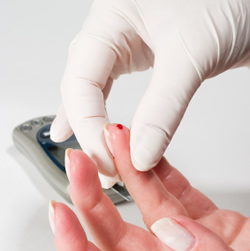Glucose Testing in Australia Pharmacy
BLOOD GLUCOSE TESTING
Where is the best place to obtain blood for measuring blood glucose levels?
It is usually easiest to obtain blood from the fingertips. You can use either the pulp, which is the fleshy part of the fingertip, or the sides of the fingertips. The sides of the fingertips are less sensitive than the pulp. Some people like to use the area just below the nailbed. It may be necessary for people such as guitarists, pianists or typists to avoid the finger pulp. There are a couple of meters that allow blood to be taken from the arm. 
Which is the best finger pricking device?
All blood lancets (finger prickers) are very similar and there is little to choose between them. The lancets may be used either on their own or in conjunction with an automatic device. They are obtainable on prescription from your CP. Alternatively they can be bought from a chemist, or ordered by post from companies such as Owen Mumford (Medical Shop).
The automatic devices work on the principle of hiding the lancet from view while piercing the skin very quickly and at a controlled depth. The meter you are using will have had an accompanying finger pricking device. They are not available on prescription, but can be obtained from the manufacturer of your meter or by post from companies such as Owen Mumford.
Should I clean my fingers with spirit or antiseptic before pricking them?
We do not recommend that you use spirit for cleaning your fingers. Spirit or antiseptic could interfere with the test strip and cause soreness if you have recently pricked the same finger. We suggest that you wash your hands with soap and warm water, or only water, and dry them thoroughly before pricking your finger. The main reason for having a clean finger is to remove any contamination, such as food, that may cause a false blood glucose result.
Will constant finger pricking make my fingers sore?
You may find that your fingers feel sore for the first week or two after starting blood glucose monitoring but this seems to settle down. We have seen many people who have been measuring their blood glucose levels regularly three or four times a day for more than 15 years and who have no problems with sore fingers. The more up-to-date meters use very small amounts of blood and so you don’t need to prick your finger too brutally! Don’t always use the same finger – try to use different fingers in turn.
Will my fingers take a long time to heal after finger pricking and am I more likely to pick up an infection there?
Your fingertips should heal as quickly as those of someone without diabetes, but make sure that you are using suitable blood lancets. We have seen only one infected finger among many hundreds of thousands of finger pricks. As long as your hands are clean when you take your blood sample, you should not have any problems.